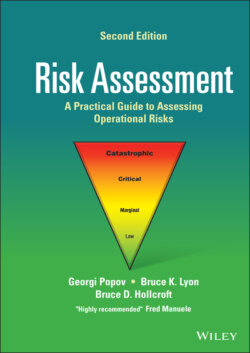Читать книгу Risk Assessment - Georgi Popov - Страница 20
1.4 The ANSI/ASSP Z690 – 2011 Series
ОглавлениеThe ANSI/ASSP Z690 Risk Management Standards are the US national standards for applying risk management for occupational safety and health. They are the US adoption of the ISO 31000 Risk Management Standards.
The three ANSI Standards that constitute a set should be of interest to safety generalists who want to become familiar with risk assessment techniques. The ASSP is the secretariat. Comments on the three standards follow:
ANSI/ASSP Z690.1 – 2011: Vocabulary for Risk Management (National Adoption of ISO Guide 73:2009). This standard provides definitions of terms that, the originators hope, will be used in other standards.
ANSI/ASSP Z690.2 – 2011: Risk Management Principles and Guidelines (National Adoption of ISO 31,000:2009). The intent of this standard is to provide a broad‐range primer on risk management systems that could be applied in any type of organization. The requirement for risk assessments is introduced in Section 5.4: Risk Assessment.
ANSI/ASSP Z 690.3 – 2011: Risk Assessment Techniques (National Adoption of IEC/ISO 31,010:2009). For safety generalists who want a ready reference on risk assessment concepts and methods, this standard is worth acquiring. It commences with a 15‐page dissertation on risk assessment concepts and methods. Appendix A, in five pages, provides brief comparisons of 31 risk assessment techniques. Comments on the 31 techniques, covering Overview, Use, Inputs, Process, Strengths, and Limitations, are provided in Annex B which covers 79 pages.
ANSI/ASSP Z 690.3 – 2011, particularly, is a valuable resource. A list of the 31 risk assessment techniques follows. Some could be applied only by experienced safety professionals who had knowledge of system safety concepts and techniques. Other techniques would be used by probabilistic specialists. However, having knowledge of a few of them will serve for a huge percentage of the needs of a safety generalist.
| B01 | Brainstorming | B02 | Structured or Semi‐Structured Interviews |
| B03 | Delphi | B04 | Checklists |
| B05 | Preliminary Hazard Analysis | B06 | Hazard and Operability Studies |
| B07 | Hazard Analysis and Critical Control Points | B08 | Environmental Risk Assessment |
| B09 | Structure – What if Analysis | B10 | Scenario Analysis |
| B11 | Business Impact Analysis | B12 | Root Cause Analysis |
| B13 | Failure Mode Effect Analysis | B14 | Fault Tree Analysis |
| B15 | Event Tree Analysis | B16 | Cause and Consequence Analysis |
| B17 | Cause‐and‐Effect Analysis | B18 | Layer Protection Analysis |
| B19 | Decision Tree | B20 | Human Reliability Analysis |
| B21 | Bow Tie Analysis | B22 | Reliability Centered Maintenance |
| B23 | Sneak Circuit Analysis | B24 | Markov Analysis |
| B25 | Monte Carlo Simulation | B26 | Bayesian Statistics and Bayes Nets |
| B27 | FN Curves | B28 | Risk Indices |
| B29 | Consequence/Probability Matrix | B30 | Cost Benefit Analysis |
| B31 | Multi‐Criteria Decision Analysis |
In the Z590.3 standard, this statement is made (p. 23). “As a practical matter, having knowledge of three risk assessment concepts will be sufficient to address most, but not all risk assessment situations” (that safety professions will face). They are Preliminary Hazard Analysis and Risk Assessment; the What‐If/Checklist Analysis Methods; and Failure Mode and Effects Analysis.
